#Owen Garriott
Text


Scientist-astronaut Owen K. Garriott, Skylab 3 science pilot, looks at the camera as he participates in the August 6, 1973 extravehicular activity (EVA) during which he and astronaut Jack R. Lousma, pilot, deployed the twin pole solar shield to help shade the Orbital Workshop (OWS).
NASA
30 notes
·
View notes
Text
Ryu Number: Owen Garriott
Owen Garriott was an American astronaut who spent approximately two months in Skylab 3, taking—at the time—the shared world record for longest spaceflight (it'd be broken less than half a year later, but that's still awesome). More relevantly for us (i.e. those of us interested in Ryu Numbers), he was the father of Richard Garriott, the creator of the Ultima game series, so it's no surprise that the latter stuck a cameo of the former in Ultima II: The Revenge of the Enchantress:
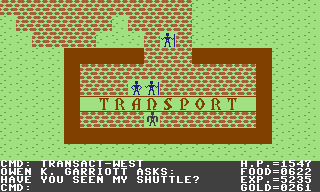
That's the finish line. The problem, as always, is getting there.
It's generally accepted that each Ultima game features the same individual as protagonist—that is, that the same repeat isekaiee stars in each major installment of the series. Assuming that this is true, and that this protagonist—referred to by lore as "The Stranger" or "The Avatar"—is the same dude whichever game they're in, Owen Garriott has a Ryu Number of at most 4.
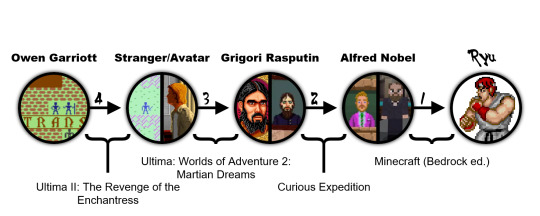
That said, early installments of the Ultima series were a bit iffy on whether the protagonist was the same individual game to game, so maybe you're iffy, too. Fair enough! You can still get a Ryu Number of at most 4 for Owen Garriott following an alternate route.

Apologies if you're learning it just now, but there's a fighting game where you can have Santa Claus and the Buddha duke it out. It's on Steam. Jesus is there, too, but Santa Claus seemed funnier.
Oh, and apparently the Buddha is in some versions of Ultima IV. You know he's the Buddha because when you talk to him he says, "I am Buddha," and says stuff at you from the Dharmapada. Which may seem odd, but if I had a list of historical or public domain individuals I wouldn't be too surprised by seeing after getting isekaied to another world, the Buddha would be up there. That's so Buddha!
"But my guy," says the imaginary version of you I've built up in my head without actually knowing you, "'Buddha' is a title. This Britannian dude could be any old Buddha! The Theravadas acknowledge twenty-nine of them, and they're on the stingy end!"
To which I say: Come on, my dude, you know that whenever anyone west of the prime meridian says "Buddha" they're talking about Gautama. Are you really gonna make me do this?
Fine.

Yes, Short Round is also in Ultima IV.

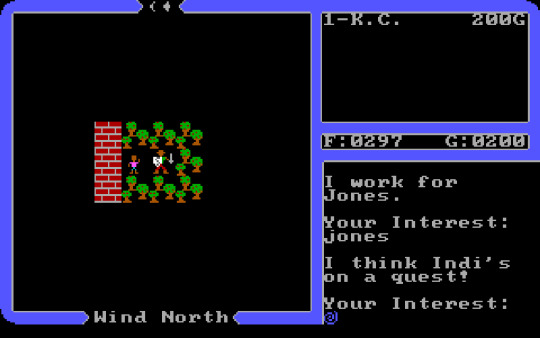
(Bonus: Non-Minecraft routes:)
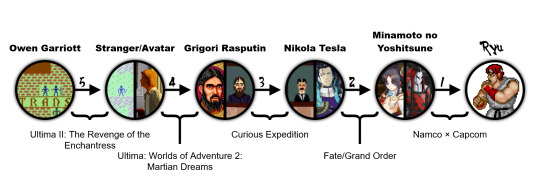
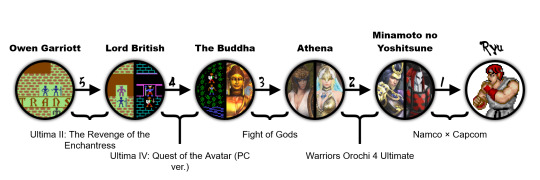

#ryu number#owen garriott#ryu#minecraft#minecraft (bedrock ed.)#alfred nobel#curious expedition#grigori rasputin#ultima: worlds of adventure 2: martian dreams#stranger#avatar#ultima ii: the revenge of the enchantress#santa claus#fight of gods#the buddha#buddha#ultima iv: quest of the avatar#ultima iv: quest of the avatar (pc ver.)#lord british#luke skywalker#lego star wars: the complete saga#indiana jones#lego indiana jones: the original adventures#short round#namco x capcom#minamoto no yoshitsune#fate/grand order#nikola tesla#warriors orochi 4#warriors orochi 4 ultimate
6 notes
·
View notes
Text
Skylab Missions: Skylab 3

*
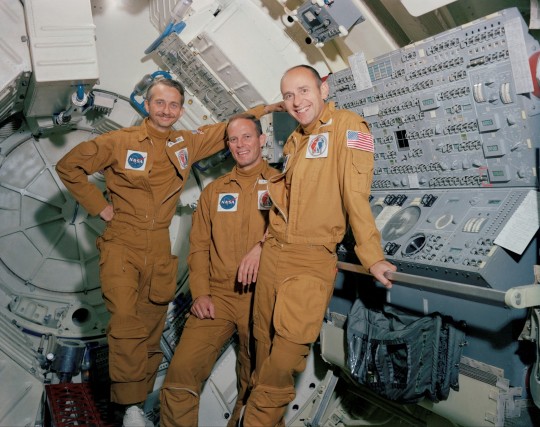
"These three men are the prime crewmen for the Skylab 3 mission. Pictured in the one-G trainer Multiple Docking Adapter (MDA) at the Johnson Space Center (JSC) are, left to right, scientist-astronaut Owen K. Garriott, science pilot; and astronauts Jack R. Lousma and Alan L. Bean, pilot and commander, respectively."
Mission Duration: July 28 - September 25, 1973
Time Duration: 58 days, 15 hours, 39 minutes, 42 seconds
"The Skylab 3 mission started out as routine, but was not without in-flight high drama of its own. Shortly after docking and entering the Orbital Workshop (OWS), all three crew members experienced motion sickness, delaying the activation of OWS on-board equipment.
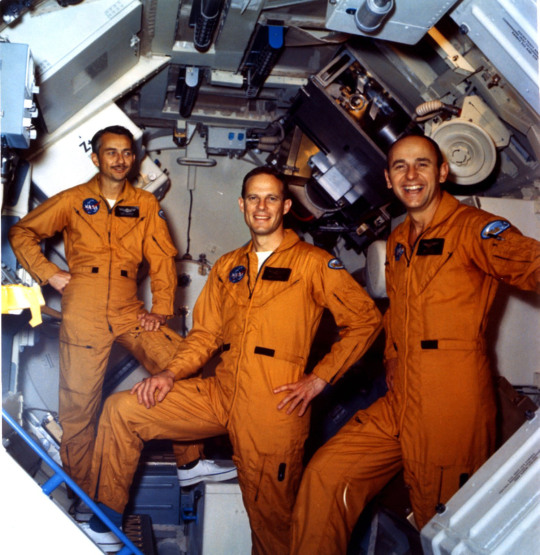
A more serious concern was raised on Mission Day-5 (MD-5). An apparent failure of two of the four thruster quadrants of the Command Service Module (CSM) reaction control system was detected.
Not only could an actual failure like this create an early end to the mission, it also could conceivably render the CSM incapable of supporting a safe return of the astronauts to Earth.
Launch crews at the Kennedy Space Center were placed on a 24-hour per-day, seven day per-week work schedule to prepare the Skylab 4 Saturn IB launch vehicle for flight in case an early launch was needed for a rescue operation."

The Skylab 4 Saturn IB (CSM-118/SA-208) launch vehicle is rolled to Launch Complex 39, Pad B.
"A decision was made to continue the mission, and although the Skylab 4 launch vehicle had been rushed to flight-readiness, the CSM performed flawlessly during re-entry operations.
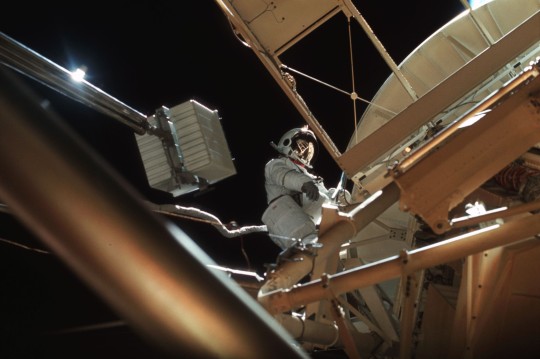
On August 6, 1973 astronauts Garriott and Lousma performed a spacewalk which lasted 6 hours, 31 minutes. During this spacewalk, the astronauts were able to extend an external twin-pole thermal shield to replace the parasol thermal shield installed by the Skylab 2 crew. They also retrieved and replaced film from solar telescopes housed outside the OWS.
A second spacewalk by astronauts Garriott and Lousma was conducted on August 24, 1973. This one lasted 4 hours, 31 minutes. During this spacewalk, the astronauts retrieved and replaced film from solar telescopes housed outside the OWS and installed a cable for a new rate gyro package. They also performed some maintenance activities.
The third and final spacewalk of the mission was conducted on September 22, 1973. This one was conducted by astronauts Bean and Garriott and lasted 2 hours, 41 minutes. During this spacewalk, the astronauts retrieved and replaced film from solar telescopes housed outside the OWS and performed maintenance activities on other external experiment packages.
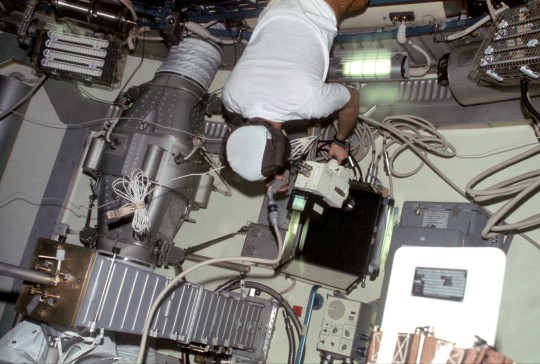

Scientific experiments, including the observation of unanticipated dynamic solar activity, continued for much of the 59-day mission. The crew participated in classroom-oriented educational demonstrations regarding weightlessness.
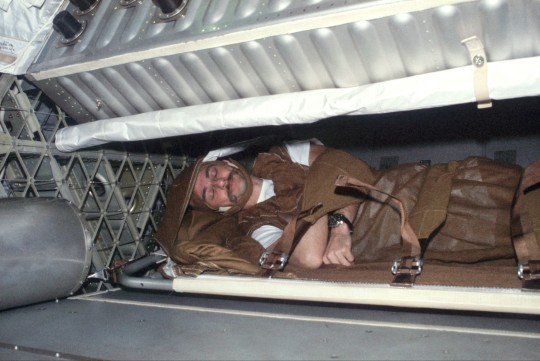
The Skylab 3 crew set a new manned space flight endurance record. Their in-flight health fared markedly better than the Skylab 2 crew, with the exception of the amount of bone calcium loss.

A significant demonstration of long-term space flight and the long-term viability of the OWS was successfully achieved."
* Due to a NASA management error, crewed Skylab mission patches were designed in conflict with the official mission numbering scheme.

An interesting side note, the wives created their version of the patch. I've covered the NSFW bits just so the Tumblr staff doesn't mark my blog as NSFW.
"The main feature on the second Skylab crew patch was Leonardo da Vinci's universal man, slightly retouched to make it 'G-rated'! Without their husbands knowledge, the astronaut wives also had a patch made which was a joke version of the official crew patch. The universal man figure had been replaced by a 'universal woman'. Instead of the astronauts names; Bean, Garriott and Lousma, their wives first names were shown: Sue, Helen-Mary and Gratia. The crew first became aware of the wives patch when they found stickers of them in their lockers on board Skylab."
source, source
NASA ID: S72-51123, S73-28714, 72-HC-90, SL3-108-1288, SL3-109-1345, S74-15583, SL3-111-1505, S73-34369, SL3-117-2109
#Skylab III#Skylab 3#SL-3#SLM-2#NASA#Apollo Program#Apollo Applications Program#Skylab Orbital Workshop#Skylab OWS#Skylab#Space Station#July#September#1973#Saturn IB#CSM-118#SA-208#rocket#rollout#Kennedy Space Center#KSC#Florida#my post
99 notes
·
View notes
Text
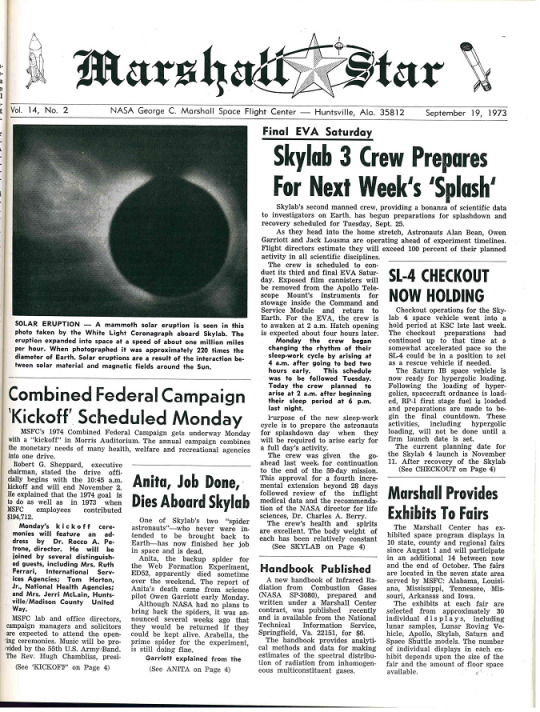
This edition of the Marshall Star from 1973, a newsletter of the George C. Marshall Space Center in Huntsville, Alabama, features an article titled “Anita, Job Done, Dies Aboard Skylab.”
The article goes on to explain that Anita was the back-up spider in the Web Formation Experiment. The primary spider, Arabella, was still alive at the time of the newsletter. Arabella’s current whereabouts are unknown.
Record Group 255: Records of the National Aeronautics and Space AdministrationSeries: Marshall StarFile Unit: Marshall Star Volume 14
Marshall Star Vol. 14, No. 2 . NASA George C. Marshall Space Flight Center -- Huntsville, Ala. 35812 . September, 1973 Final EVA Saturday Skylab 3 Crew Prepares For Next Week's 'Splash' Skylab's second manned crew, prvoding a bonanza of scientific data to investigators on Earth. has begun preparations for splashdown and recovery scheduled for Tuesday, Sept. 25. As they head into the home stretch, Astronauts Alan Bean, Owen Garriott and Jack Lousma are operating ahead of experiment timelines. Flight directors estimate they will exceed 100 percent of their planned activity in all scientific disciplines. The crew is scheduled to conduct its third and final EVA Saturday. Exposed film cannisters will be removed from the Apollo Telescope Mount's instruments for stowage inside the Command and Service Module and return to Earth. For the EVA, the crew is to awaken at 2 a.m. Hatch opening is expected about four hours later. Monday the crew becan changing the rhythm of their sleep-work cycle by arising at 4 a.m. after goint to bed two hours early. This schedule was to be followed Tuesday. Today the crew planned to arise at 2 a.m. after beginning their sleep period at 6 p.m. last night. Purpose of the new sleep-work cycle is to prepare the astronauts for splashdown day when they will be required to arise early for a full day's activity. The crew was given the go- ahead last week for continuation to the end of the 59-day mission. This approval for a fourth incremental extension beyond 28 days followed review of the inflight medical data and the recommendation of the NASA director for life sciences, Dr. Charles A. Berry. The crew's health and spirits are excellent. The body weight of each has been relatively constant (See SKYLAB on Page 4) SOLAR ERUPTION -- A mammoth solar eruption is seen in this photo taken by the White Light Coronagraph about Sklyab. The eruption expanded into space at a speed of about one million miles per hour. When photographed it was approximately 220 times the diameter of Earth. Solar eruptions are a result of the interaction between solar material and magnetic fields around the Sun. Combined Federal Campaign 'Kickoff' Scheduled Monday MSFC's 1974 Combined Federal Campaign gets underway Monday with a "kickoff" in Morris Auditorium. The annual campaign combines the monetary needs of many health, welfare and recreational agencies into one drive. Rober G. Sheppard, executive chairman, stated the drive officially begins with the 10:45 a.m. kickoff and will end November 2. He explained that the 1974 goal is to do as well as in 1973 when MSFC employees contributed $194,712. Monday's kickoff ceremonies will feature and address by Dr. Rocco A. Petrone, director. He will be joined by several distinguished guests, including Mrs. Ruth Ferrari, International Services Agencies; Tom Horton, Jr., National Health Agencies; and Mrs. Jerri McLain, Huntsville/ Madison County United Way. MSFC lab and office directors, campaign mangers and solicitors are expected to attend the opening ceremonies. Music will be provided by the 55th U.S. Army Band. The Rev. Hugh Chambliss, presi- (See 'KICKOFF' on Page 4)
Anita, Job Done, Dies Aboard Skylab One of Skylab's two "spider astronauts" --who never were intended to be brought back to Earth--has now finished her job in space and is dead. Anita, the backup spider for the Web Formation Experiment, ED52, apparently died sometime over the weekend. The report of Anita's death came from science pilot Owen Garriott early Monday. Although NASA had no plans to bring back the spiders, it was announced several weeks ago that they would be returned if they could be kept alive. Arabella, the prime spider for the experiment, is still doing fine. Garriott explained from the (See ANITA on Page 4)
28 notes
·
View notes
Text

NASA astronaut Don Leslie Lind PhD
American physicist, naval aviator Don Leslie Lind was selected an astronaut in NASA Group 5 in April 1966.
During the Apollo era, Lind served as CapCom – Capsule Communicator during Apollo 11 and 12. By 1971, Lind was assigned as backup pilot for the Skylab space station missions 3 and 4, as well as being a crew member for a potential Skylab Rescue mission.
Finally, in April 1985, Lind flew onboard space shuttle Challenger mission 51-B, spending 7 days in space.
In this 1981 official NASA portrait, Don Lind wore his yellow dial Seiko 6139 automatic chronograph, a watch he had been wearing since Skylab training in 1973.
Other Apollo era astronauts wearing a Seiko 6139 included William Pogue, Owen Garriott and James Irwin.
(Photo: NASA)
#Aviator#Astronaut#NASA#chronograph#automatic#6139#military#montres#moonwatchuniverse#spaceflight#uhren#pilot watch#US Navy#space shuttle#Zulu time#Seiko
9 notes
·
View notes
Text
A Canadian military surveillance aircraft detected underwater noises as a massive operation searched early Wednesday in a remote part of the North Atlantic for a submersible that vanished while taking five people down to the wreck of the Titanic.
A statement from the U.S. Coast Guard did not elaborate on what rescuers believed the noises could be, though it offered a glimmer of hope for those lost aboard the Titan. The vessel is estimated to have as little as a day's worth of oxygen left if it is still functioning.
Three search vessels arrived on-scene Wednesday morning, including one that has side-scanning sonar capabilities, the Coast Guard tweeted.
The Coast Guard wrote on Twitter that a Canadian military surveillance aircraft had “detected underwater noises in the search area" and that an underwater robot sent to search that area has so far “yielded negative results.”
Still, authorities pushed on Wednesday to get salvage equipment to the scene in case the sub is found.
The Coast Guard statement about detecting sounds underwater came after Rolling Stone reported that search teams heard “banging sounds in the area every 30 minutes.”
The report was encouraging to some experts because submarine crews unable to communicate with the surface are taught to bang on their submersible’s hull to be detected by sonar.
“It sends a message that you’re probably using military techniques to find me and this is how I’m saying it," said Frank Owen, a submarine search and rescue expert. "So, that’s really encouraging if that’s the case.”
Richard Garriott de Cayeux, the president of The Explorers Club, wrote an open letter to his club’s adventurers, saying he had “much greater confidence” about the search after speaking to officials in Congress, the U.S. military and the White House.
However, no official has publicly suggested they know the source of the underwater noises.
Meanwhile, questions remain about how teams could reach the lost submersible, which could be as deep as about 12,500 feet (3,800 meters) below the surface near the watery tomb of the historic ocean liner. Newly uncovered allegations also suggest there had been significant warnings made about vessel safety during its development.
Lost aboard the vessel are pilot Stockton Rush, the CEO of the company leading the expedition. His passengers are a British adventurer, two members of a Pakistani business family and a Titanic expert.
Three transport planes from the U.S. military have been used to move commercial submersible and support equipment from Buffalo, New York, to St. John’s, Newfoundland, to aid in the search, a spokesperson for U.S. Air Mobility Command said.
The Canadian military said it provided a patrol aircraft and two surface ships, including one that specializes in dive medicine. It also dropped sonar buoys to listen for any sounds from the Titan.
Authorities reported the 22-foot carbon-fiber vessel overdue Sunday night, setting off the search in waters about 435 miles (700 kilometers) south of St. John’s.
The submersible had a four-day oxygen supply when it put to sea around 6 a.m. Sunday, according to David Concannon, an adviser to OceanGate Expeditions, which oversaw the mission.
Owen said the estimated 96-hour oxygen supply is a useful “target” for searchers, but is only based on a “nominal amount of consumption the average human might consume in doing certain things.” Owen said the diver on board the Titan would likely be advising passengers to “do anything to reduce your metabolic levels so that you can actually extend this 96 hours.”
Chris Brown, a British adventurer who paid a deposit to go on the Titan voyage but later withdrew because of what he called safety concerns, said word that the searchers have heard sounds is both good news and bad news.
“If the sounds are coming from below the water indicator then that indicates that they may be alive in the water, but now we’ve got time pressures in getting them up to the surface,” Brown told ABC’s “Good Morning America” Wednesday.
The submersible had seven backup systems to return to the surface, including sandbags and lead pipes that drop off and an inflatable balloon.
Aaron Newman, who has been a passenger on the Titan, told NBC’s “Today” show Wednesday that if the submersible is below a couple hundred meters and without power, the passengers are in complete darkness and it's cold.
“It was cold when we were at the bottom,” he said. “You had layered up. You had wool hats on and were doing everything to stay warm at the bottom.”
Meanwhile, documents show that OceanGate had been warned there might be catastrophic safety problems posed by the way the experimental vessel was developed.
David Lochridge, OceanGate’s director of marine operations, said in a 2018 lawsuit that the company’s testing and certification was insufficient and would “subject passengers to potential extreme danger in an experimental submersible.”
The company insisted that Lochridge was “not an engineer and was not hired or asked to perform engineering services on the Titan.” The firm also says the vessel under development was a prototype, not the now-missing Titan.
The Marine Technology Society, which describes itself as “a professional group of ocean engineers, technologists, policy-makers, and educators,” also expressed concern that year in a letter to Rush, OceanGate’s chief executive. The society said it was critical that the company submit its prototype to tests overseen by an expert third party before launching in order to safeguard passengers. The New York Times first reported about those documents.
The search for the missing vessel has drawn international attention. In Dubai, where the missing British adventurer Hamish Harding lives, Crown Prince Hamadan bin Mohammed Al Maktoum wrote: “Dubai and its people pray for their safety and hopeful return home.”
Others aboard include Pakistani nationals Shahzada Dawood and his son Suleman, whose eponymous firm invests across the country. In Pakistan's port city of Karachi, employees at his firms said they prayed for the two's safe return, as did government officials. French explorer and Titanic expert Paul-Henry Nargeolet also was on the vessel.
Describing Harding and Nargeloet as “tourists” is a misnomer, said Newman, the former Titan passenger.
“These are people who lived on the edge and loved what they were doing. If anything’s going on, these are people that are calm and thinking this through and doing what they can to stay alive,” Newman said, adding that he felt safe and in the hands of professionals on his descent. “It’s a good set of people.”
13 notes
·
View notes
Video
youtube
Back when “Artemis” was called “Constellation”, and “SLS” was called “Ares V”, your humble editor testified before the US Review of Human Spaceflight Plans Committee. (The thumbnail is Sally Ride, though, not me!)
I was feeling decidedly unwell that morning, so I managed to get the first slot in the queue for public comments. I don’t think I gave a very good showing for that reason, but at least I didn’t vomit on Owen Garriott or Gene Kranz (as at one point I was afraid would happen). If you get lost in this five-and-a-half-hour-long video, look for me at around 4h55m in.
For some reason, NASA originally posted the recordings of the sessions on Vimeo, and they’re “unrated”, so you have to log in to view them. Assorted links (including one to a text transcript of the whole thing) can be found here.
1 note
·
View note
Link
For only the second time, VSS Unity, Virgin Galactic’s suborbital space plane, was transformed into a science laboratory. Galactic 05 successfully completed its mission on Nov. 2, but for Kellie Gerardi, Galactic 05 crewmember and Virgin Galactic Astronaut 021, the training and preparation for the flight goes back almost a decade. She sat down with NSF to detail what it takes to conduct commercial suborbital research. Gerardi said her training began two years before the flight, but unofficially started a decade ago. She volunteered as a coat checker at the Explorers Club in New York City while in college. The organization is an esteemed society that aims to promote and recognize pioneers in scientific exploration and field study. Honorees include the Apollo 11 crew, Elon Musk, Sir Edmund Hillary, and more. Kellie Gerardi in her flight suit prior to the mission. (Credit: Virgin Galactic) While volunteering, she met Richard Garriott de Cayeux, a video game designer who, in addition to being the son of NASA astronaut Owen Garriott, purchased a seat aboard a Russian Soyuz rocket and visited the International Space Station in 2008. Gerardi thanks Garriott de Cayeux for first introducing her to the idea of commercial spaceflight. “I graduated the same year that the space shuttle program retired, and I was oblivious to the existence at that time of this sort of nascent commercial industry and it blew my mind,” Gerardi said. “I just remember thinking ‘I want to be a part of that’ and so the goal was never even originally how do I get myself to fly? It was how do I help create the Star Trek future where we’re democratizing access to space, we’re expanding Earth’s economic sphere?” That encounter led her to meet the Suborbital Researchers Group, which included Dr. Alan Stern, who would fly alongside her on Galactic 05. Gerardi worked with the Defense Advanced Research Projects Agency (DARPA) before joining Masten Space Systems. During that time, she was able to work a few test stands away from Virgin Galactic’s work zone in the Mojave Desert. She got her first taste of astronaut life and hands-on research while participating in an analog mission at the Mars Desert Research Station while joining the International Institute for Astronautical Sciences (IIAS) in 2017. “I was supposed to be there in 2016, but I was pregnant and couldn’t fly,” Gerardi said. “So, literally right after I gave birth, and when I say literally, I mean I was still wearing Spanx under my flight suit to keep all of my organs in place, I was like right there. That was really exciting because we tested a real prototype of their EVA suit during the Mars Desert Research Station rotation.” Kellie Gerardi donning her EVA suit as part of Mars Desert Research Station Crew 149. (Credit: Kellie Gerardi) During this time, she began working for Palantir. All of these experiences would lead Gerardi to her first flight to the edge of space. IIAS shared which experiments they planned to fly with Virgin Galactic more than two years before the actual flight took place, Gerardi said. When she found out she would be flying those experiments, she had a different reaction than most might expect. Gerardi aboard a microgravity training flight. (Credit: Kellie Gerardi) “I know that I’m supposed to say I never could have dreamed of this, but that wouldn’t be true because I dreamed of that in detail, excruciating detail,” Gerardi said. “When I knew that I was having the opportunity to fly, of course it’s like an overwhelming gratitude for the trust that IIAS is placing in me, the confidence they’re placing in me, the pressure that is being placed on my shoulders to be the, you know, best ambassador that I could be, not only for IIAS but also for suborbital science generally, for the commercial space industry, for women in STEM, for just like, you know, pick your sort of roulette slot, and I felt a sense of pressure to live up to those expectations.” Gerardi says she and Dr. Stern both agreed one of their most useful experiences in preparing for the actual flight was parabolic microgravity flights, where an airplane pitches up, giving passengers nearly 2G of force pushing against them, before pitching over and downward in the shape of a parabola, allowing just under 30 seconds of near zero-G conditions. Gerardi and Stern partnered with the National Research Council of Canada, which allowed for microgravity training aboard a Dassault Falcon 20 aircraft. “It is a very dynamic environment in space, especially like immediately post-boost, and you’ve got the main engine cutoff (MECO), and then you’ve got the coast to apogee, but when the reaction control system (RCS) is firing in that vehicle, it’s like something that was two inches away is now two feet away, and the vehicle inverts,” Gerardi said. “So that part of flight, it’s like you can academically prepare for it, and you know what’s going to happen, and they prepare you so well. But when you’re experiencing it, it’s like, thank God we had that muscle memory to rely on of parabolic flight, because when you’re doing something with fine motor, like I’m opening a payload stowage solution, I’m unstowing, I’m securing, I’m doing things, and that I don’t think I would have been able to do had I not had that extensive experience in microgravity.” IIAS facilities in Florida also allowed for flights aboard an Extra 300 for high-G training. There was one additional piece of training that happened before getting hands-on experience at Spaceport America in New Mexico; training to use a maximum absorbency garment (MAG). “This was just not on my vision board when I dreamed of going to space as a little girl,” Gerardi said. She said they were instilled with the importance of hydration. “You’re in the desert and it’s so hot, and if there is a delay, you don’t want to accidentally restrict your hydration,” Gerardi noted. “Hydration really makes a difference with G tolerance. If you’re dehydrated, you can lose up to half a G of tolerance in your ability to withstand high G-forces. So it’s really important. So I understood why MAGs are so important and helpful.” She also noted it could be helpful for somebody who might have a nervous bladder to be able to fully enjoy the flight. Besides field testing it, she noted something special about hers. “It was space-themed,” Gerardi noted while chuckling. “It was like little kids like drawing [a] space-themed diaper. So yeah, it was really funny.” Ships mated? Research teams onsite? Astronauts in training? Must be a spaceflight week #Galactic05 is tracking for this Thursday, November 2. pic.twitter.com/D7pIGSIReg — Virgin Galactic (@virgingalactic) October 30, 2023 One week before the flight, the crew arrived for official pre-flight training in New Mexico. Gerardi notes the training for herself and Dr. Stern was different from the third passenger, Ketty Maisonrouge, who was participating as a paying customer as opposed to a researcher. “That was just because there’s different operational and safety concerns when you’re free-floating things or like stowing things,” Gerardi noted. Training included practice inside a simulator as well as inside the actual ship, VSS Unity. “They have a full mock-up of the vehicle that they close off and they run with audio, pilot audio, and visual out the windows,” Gerardi remembered. “You see like on screens like you dropping away from [the mothership] Eve. And so those were really high-fidelity simulations that were built to spec. And so we ran through those, Alan and I ran through those with our payload team a number of times.” She noted that throughout the whole process, the Federal Aviation Administration (FAA) was watching. That included someone from the FAA present via Zoom during key tests including bailout and oxygen training. Gerardi undergoing hypoxia training in 2021. (Credit: Kellie Gerardi) When it came to the training aboard the actual space plane, Gerardi compared it to memorizing choreography. She said the last thing she wanted was to be the first participant allowed to free-float an experiment and mess it up, removing the ability for future flyers to perform something similar. “I mean even the night before I was in my hotel room with a blindfold on doing a one-handed version of the release [of the payload] over and over again,” Gerardi said. “I had a backup mock-up and just practicing so that even if all other senses were impaired, I was going to be able to get that thing safely stowed.” Gerardi’s three experiments included the previously mentioned free-floating experiment known as “Configuration of a Confined Fluid in a Low-Gravity Environment,” with the goal of better predicting and controlling the shape of fluids in microgravity to help prevent an incident like in 2013 when ESA astronaut Luca Parmitano nearly drowned during a spacewalk as a result of a clogged filter. The hope is to also use the data to develop syringe designs for administering medicine in space. She wore Astroskin, a biomonitoring device that is also currently used aboard the ISS. This device tracks body functions such as heart rate, breathing rate, and skin temperature, with Gerardi’s mission marking the first time it was used to collect data during the launch, re-entry, and landing phases of flight. .@KellieGerardi is wearing an Astroskin biomonitoring device developed with the support of the Canadian Space Agency (@CSA). Fun Fact: The Astroskin is currently in use by astronauts aboard the @ISS! #Galactic05 marks the first time this technology will be used during launch,… pic.twitter.com/yXNlpSBwo2 — Virgin Galactic (@virgingalactic) November 2, 2023 Gerardi also wore a continuous blood glucose monitor. This was attached a few days before her flight and she was wearing it when this interview was conducted less than a week after her flight. The monitor was used to gather data that may help to address concerns that insulin resistance might develop more quickly during spaceflight. One of the key differences Gerardi noted in the training for Galactic 05 compared to other vehicles was the ability to make changes to payload storage and functions on the plane as late as the day before flight. Those plans are typically finalized months in advance on longer-duration spaceflights. “Alan changed one of the stowage solutions for his payload with his carabiner and his tether the day before flight,” Gerardi remembered. “It was such a better solution, too, that if we had been of, I don’t know, restricted to dogmatically enforced timelines just for the sake of locking it in, but without the ability to have any sort of pragmatic thinking, we would have had a suboptimal solution that could have resulted in us interfering with each other’s choreography.” Gerardi notes one of her biggest struggles was to be able to turn on a GoPro camera and verify that it was recording 15 minutes prior to release. What research is @KellieGerardi conducting during #Galactic05? Let’s discuss! First: Kellie’s fluids experiment will free float in the spaceship cabin to examine how a confined fluid behaves in low gravity. Data gathered from the #Galactic05 spaceflight can help inform a range… pic.twitter.com/4Rp6NTnmYY — Virgin Galactic (@virgingalactic) November 2, 2023 “The payload was right next to me on my right side, and only with my middle finger could I like barely graze the top, but I wouldn’t be able to check that the light was on and can you imagine if I did all of this and the GoPro light wasn’t on,” Gerardi anxiously remembered? “What I ended up being able to do was loosen one of my left shoulder straps, maintain positive control of it, but maneuver my body to reach down and check and see the light reflecting off of my finger from the GoPro and then re-strap up and tell them cabin was secure, and the fact that I was able to make those modifications, it was great to be able to work with the [Virgin Galactic] team.” Then it all came down to flight day. Gerardi said her suit was hung out for her similar to how her wedding dress was when she got married. Then it was time to board Unity. “I mean that was maybe one of the most profound parts of the flight seeing all my family and friends, amazing, as we were taxiing away, but the last thing I saw was all of the Virgin Galactic flight line engineers in a line waving us off and sending us off,” Gerardi recalled. “I know what it’s like to send hardware to space and to feel that, but sending colleagues and humans and people that you just sealed off and put in there. I mean, it was just, I had chills kind of from that visual and it was so meaningful.” The Galactic 05 crew walking out on launch day. (Credit: Virgin Galactic) The mothership Eve, with VSS Unity underneath, took off at 9:00 AM local time from Spaceport America, beginning a climb to a release altitude near 50,000 feet. Gerardi remembered the clear blue skies that day, including her family being able to see the entirety of her flight from the ground. However it was something in the air that jumped out at her. “I got to see this gradient of blue going from the lightest to the darkest navy and then it got really dark real quick,” Gerardi said with a child-like smile across her face. “For a few moments circling at that release altitude, I just thought it was the most beautiful thing in the world. And then a few minutes later I thought something else was the most beautiful thing in the world. But it was, like, staggering. That mental picture stands out to me on most immediate recall.” Then came the moment of release, which Dr. Stern called ‘surreal.’ “You’re dropped and you just watch Eve go, whoosh, and then all of a sudden, you’re flat on your back, and it’s like riding a rocket to the stars,” Gerardi vividly remembered. “I mean, you’re just going backwards, and you feel that you’re riding a rocket. Like, it is right behind you…I’ve done a ton of high-G flights. I’ve done centrifuge training, I’ve done it all, but just being on your back and riding a rocket to the stars was like, I just, it was like sci-fi. And it was so cool.” Galactic 05 drop and ignition. Another suborbital spaceflight in the books! Congratulations @AlanStern, @kelliegerardi, @VirginGalactic, and @Spaceport_NM! @NASASpaceflight pic.twitter.com/8LUNTABDyo — Jack Beyer (@thejackbeyer) November 2, 2023 Gerardi said she had a smile plastered on her face the entire time and is looking forward to seeing the raw flight footage to recall her expressions. “I looked at the brief clips I shared of everyone else’s faces that are taking it very seriously, and maybe even doing breathing techniques, and I’m just cheesing,” Gerardi joked. See AlsoGalactic 05 UpdatesVirgin Galactic/Orbit sectionNSF StoreClick here to Join L2 Gerardi noted there were special callouts on this flight that were specific to the research being conducted, in addition to astronaut instructor Colin Bennett calling out time increments every 20 seconds. She said that the entire first portion of the flight following unstrapping from her seat is blacked out due to her focus on completing her experiments. “I was aware that we were in space, but I was so paranoid about getting the science and doing right by my team, and doing right by so many people who had placed their faith in me that I was aware, but not present in that portion,” Gerardi said. “I was so solely focused on getting this payload safely unstowed, getting the data.” In fact, on her planned timeline, 20 seconds were allocated for acclimating to microgravity. However, Gerardi immediately jumped into the science. “I just started a free float, and in that first block, I already doubled, nearly tripled, the maximum amount of time we had ever gotten in parabolic flight of a free float,” Gerardi excitedly said. While the results of the experiment have not yet been released, Gerardi said all data will be available to the public free of charge once it is published. One thing she did note was that her experiment performed very differently than she’d expected. Kellie Gerardi conducting her fluids experiment mid-flight. (Credit: Virgin Galactic) “I had never seen the experiment behave the way it did in space, even after seeing it hundreds of times on earth and in freefall, near freefall,” Gerardi recalled. “I had never seen it behave like it did. And so I was just so excited. Everything worked so perfectly. And then I stowed it and I was like mentally cheering myself on because I got it stowed.” “So I looked like a professional. And I am a professional, but it was important to me that I looked like one too, because it was like, I was so conscious that everyone was watching, and this was the first time that Virgin had allowed someone to do what I was doing, and it was very important to me that I did right by that opportunity so that the next person has an even easier time convincing the team of what they want to do in space, free-floating-wise.” Following the completion of her experiment, Gerardi remembered the cabin being extremely quiet, saying you could hear a pin drop with no motors or RCS thrusters firing during that portion of the flight. Completing that task finally allowed her to look out the window at the Earth. “I turned out my window and I really saw space and Earth for the first time and I, it took my breath away, like it really took my breath away,” Kellie noted with her eyes starting to water. “I watched myself on video, like the breathing and the awe, I was just in a stupor and it makes me kind of emotional to think about, but I also probably interrupted everyone’s apogee experience because twice Alan told me that, and I don’t really remember this, but I just was like, ‘oh my god, oh my god’, and it’s like everyone else had already had a lot of time to look out the window and I was just so focused and so this was my first time really, really experiencing it and it was the most beautiful thing I’ve ever seen.” Gerardi’s first view of the Earth while in flight. (Credit: Virgin Galactic) As she remembered looking out the window, away from her seat 2L, Gerardi waxed philosophically, with the tears still in her eyes and a large smile on her face. “We’ve all seen, since childhood, so many pictures of the Earth and so many photos from much further away than I was, but it was the first time that I had experienced Earth as a planet,” Gerardi said happily. “I don’t quite know how to describe it, but I think I had a very academic understanding of Earth as a planet and being this cognitive dissonance of being both a part of it as a home but also away from it enough to experience it as a planet among other planets was an incredibly powerful and disorienting sensation and I just…that thin bright bright blue band of atmosphere it’s like the just fragility of it and nothing that I hadn’t seen before from images, but unlike anything I’d ever experienced before. And so it was just that and it was magical and overwhelming.” Gerardi noted with this interview being done so close to the completion of her flight that she had yet to truly process what it meant. While describing the planet, Gerardi had large, bright eyes and a smile that kept growing with each added description, as she processed the memory in real-time. She noted that there were two call-outs prior to re-entry, one of which was to get near to your seat, followed by the final call to strap in. Gerardi says she waited until the very last chance to reattach her five-point harness. Following landing, Gerardi ran to hug her daughter, Delta V, named after the impulse per unit of spacecraft mass that is needed to perform a maneuver. The moment was shared on her Instagram account, which currently has over 346,000 followers, and on TikTok where she has an audience of more than 728,000 followers. She wants the trolls and naysayers to understand the significance of the reunion portion of flight. @kelliegerardi I promised Delta I would come right back home to Earth…. Thank you @VirginGalactic ♬ Coming Home – Diddy – Dirty Money “I shared this reunion video of me and my daughter and it was just so powerful. And of course you get the trolls who are like, you were gone for less than two hours, why are you so dramatic?” Gerardi laughed. “First of all, blocked. Second of all, you know, away for only a short period of time. Like, that wasn’t the message. That’s not why my daughter was running to me. That’s not why I was running to my daughter. We’ve been away from each other for many weeks while I worked overseas. The message was that this is something that fewer than 100 women have ever had the opportunity to do in history. And the limiter has always been access and not aptitude.” “It’s like, I do not think I’m extraordinary or special in any way, and I look forward to broadening that horizon. But this was the fifth commercial flight ever for Virgin Galactic. So, one, to accomplish this from their side safely and to return me to my daughter on something that still has experimental stamped on that spacecraft and to watch my daughter watch me experience this thing that for her entire life, she’s always known from the day she was born that that was mommy’s dream. So it was all of that was layered in, in that reunion. And it had nothing to do with the time away. It had everything to do with the profundity of this moment in time and what it means.” Kellie Gerardi with her husband and daughter shortly after returning to Spaceport America after Galactic 05. (Credit: Jack Beyer for NSF) Readjusting to normal life following the trip had been tricky for the first few days post-flight. Gerardi noted that she had been crying every night before sleep, not knowing exactly why she was crying. She also recalled two funny moments while out with family. “Every time that I’m driving in the car with my husband and I turn to him and still grab his shoulder, I’m like, I left the freaking planet,” Gerardi said excitedly. “I literally keep having these moments where I have to almost grip something and tell the person next to me, I left Earth. I went to space.” One person who was happy to tell people about Gerardi’s trip was her mother, which led to the second funny moment. “We were in [a local supermarket],” Gerardi remembered with a big smile. “I was ordering sliced turkey from the deli and she’s like, ‘my daughter just got back from space’, this is like two days after we got back. I’m like, mom!” Gerardi says she hopes to continue to share her experience and the idea that in this day and age, anything is possible. “It’s not the era of, oh, you have to be the old stiff astronaut, everything’s going to be all that, right,” Gerardi asked. “I flew to space in the year of the Barbie movie, in the year of the [Taylor Swift] Eras tour, in the year of the [Beyoncé] Renaissance tour, okay? It’s like, we were going to bring it. And so, that was all top of mind for me.” The author along with Kellie Gerardi following the interview for this article. (Credit: Sawyer Rosenstein for NSF) Gerardi has published a personal book titled Not Necessarily Rocket Science: A Beginner’s Guide to Life in the Space Age, in addition to a children’s book series called Luna Muna. While reading the latter to a group of students at her daughter’s school, Gerardi came to a really unique realization. “I look at Delta and I look at all of her classmates and they literally are just like, ‘Oh yeah I could go to space one day too, but I could also do a lot of other things’ and it’s like that’s so true,” Gerardi recalled. “My gender schema was very different than my daughter’s when I was growing up. I think that’s why I wore jewelry in space.” “It’s why I had hot pink nails,” Kellie said showing them off, still sporting the bright color. “It’s why I wore friendship bracelets. Not that I did that intentionally to make a point, it’s more that I brought my full self to space and felt there was no part of me that even thought for a second I should tone it down. It’s toning it up. Get in losers we’re going to space!” Onlookers view VSS Unity after it had completed the Galactic 05 flight. (Credit: Jack Beyer for NSF) Besides hoping for more of her colleagues to get the chance to perform research in space, Gerardi hopes that type of willingness to be yourself in space will encourage even more people to pursue their dreams and achieve spaceflight: suborbital or orbital. “I think it makes it more real and accessible and authentic to people to understand, like that’s why it’s the human in human spaceflight,” Gerardi said. “If we were just sending robots, yeah, for sure, we could talk only about the hardware, but we’re not. We’re sending human beings who have periods, who have children, who have lives and communities and families and emotions and all of that gets rolled into that experience. And that was mine.” (Lead Image: From left to right, Kellie Gerardi, Dr. Alan Stern, and Ketty Maisonrouge following the Galactic 05 flight. Credit: Jack Beyer for NSF) The post From Countdown to Touchdown: Flying Aboard Virgin Galactic appeared first on NASASpaceFlight.com.
0 notes
Text
Space history for Sunday.
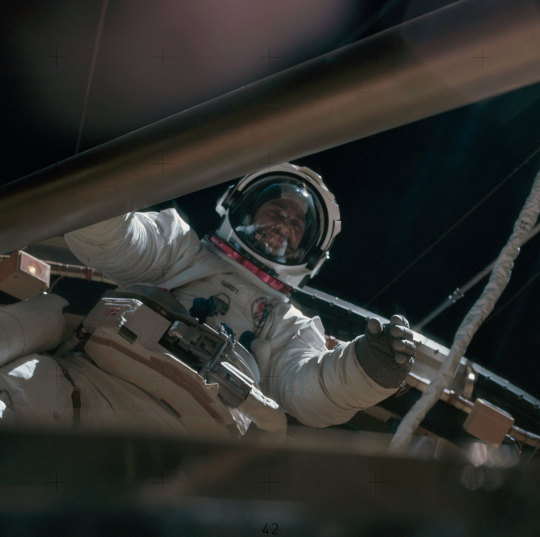
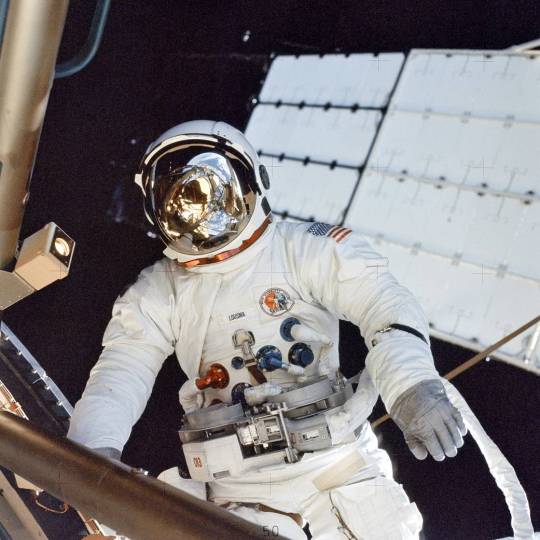
On this day in 1973, Skylab III astronauts Owen K. Garriott (top. Get a shave, dude!) and Jack R. Lousma deployed the "twin pole" solar shield to help shade the Orbital Workshop.

The solar shield built onto the workshop was torn off during launch and temperature inside the lab skyrocketed (if you will) to between 130°F to 150°F. The Skylab II crew installed the "parasol" sunshade that could be deployed from inside the spacecraft without an EVA. The "twin pole" shade augmented the "parasol" and brought temperatures down to the normal expected levels.
0 notes
Text
I really like the Skylab prank where Owen Garriott brought recordings of his wife and made NASA think she had somehow been a stowaway up there...
0 notes
Text
Through the Moongate 05 - Creative Anachronism
Through the Moongate 05 - Creative Anachronism
#ThroughTheMoongate #SCA #Ultima #Ultima1
Subscribe on Anchor | Subscribe on iTunes | Subscribe on Google Play | Subscribe on Spotify | Subscribe on TuneIn | Subscribe on Stitcher
Podcast Topic(s)
Andrea Contato’s Through the Moongate, per its Kickstarter page, “illuminates the path of the Ultima games’ history and the creative people behind this landmark series. It also covers some of Origin’s other games, especially Wing Commander,…

View On WordPress
#Apple II#Applesoft BASIC#Austin#BASIC#California Pacific#David Watson#Denis Loubet#Diana L. Paxton#Greg Dykes#Houston#International Space Station#Ken Arnold#Marion Zimmer Bradley#MOS 6502#New World Arbalest#Owen Garriott#podcast#Richard Garriott#Society for Creative Anachronism#Spam Spam Spam Humbug#Steve Jackson#Steve Jackson Games#Texas#Texas Highway Department#university of texas
2 notes
·
View notes
Text

A Saturn 1B carrying the crew of Skylab 3 lifts off from Launch Complex 39B, Kennedy Space Center. July 28, 1973.
Skylab 3 was the second crewed mission to the first American space station, Skylab, and lasted 59 days, 11 hours, and 9 minutes. Crew performed experiments in the areas of medical activities, solar observations, and Earth resources.

The crew of Skylab 3. From left: Science Pilot Owen Garriott, Pilot Jack Lousma, and Commander Alan Bean.

Composite image of four frames taken from a 16mm movie camera used by the Skylab 3 crew during their fly-around inspection of the space station. The flapping of the solar shield is caused by exhausted from a reaction control thruster on Skylab.
NASA 1, 2, 3
16 notes
·
View notes
Text

Owen Kay Garriott (November 22, 1930 – April 15, 2019)


165 notes
·
View notes
Text

"Skylab as the SL-III CM moves in for docking.
A close-up view of the Skylab space station photographed against an Earth background from the Skylab 3 Command and Service Modules (CSM) during station-keeping maneuvers prior to docking. Aboard the Command Module (CM) were astronauts Alan L. Bean, Owen K. Garriott and Jack R. Lousma, who remained with the Skylab Space Station in Earth orbit for 59 days. This picture was taken with a hand-held 70mm Hasselblad camera using a 100mm lens and SO-368 medium speed Ektachrome film. Note the one solar array system wing on the Orbital Workshop (OWS) which was successfully deployed during extravehicular activity (EVA) on the first manned Skylab flight. The parasol solar shield which was deployed by the Skylab 2 crew can be seen through the support struts of the Apollo Telescope Mount (ATM)."
Date: July 28, 1973
NASA ID: SL3-114-1683
#Skylab III#Skylab 3#SL-3#SLM-2#CSM-117#NASA#Apollo Program#Apollo Applications Program#July#1973#Space#Earth#Skylab Orbital Workshop#Skylab OWS#Skylab#Skylab I#Skylab 1#SL-1#Space Station#Apollo Telescope Mount#ATM#my post
77 notes
·
View notes
Text
In the midst of all the other bad news of the day, I’ve just learned that Owen Garriott, astronaut aboard Skylab 3 and STS-9 (Spacelab-1), has passed away. He was 88 years old. Thoughts and prayers to his family, including his son and fellow astronaut Richard, and the rest of the space community.
30 notes
·
View notes
Text

40 years ago Seiko A829 alarm chronographs in space
NASA astronaut Owen Garriott, who had flown on the Skylab space station (1973), seen onboard space shuttle Columbia mission STS-9 in November 1983.
Note the Seiko quartz Alarm chronograph with dual LCD screen, a watch which was worn on spaceflight missions between 1983 and 1996.
During the October 2008 Soyuz TMA-13 mission, Owen Garriott's son entrepreneur Richard Garriott flew as spaceflight participant onboard the International Space Station, wearing 2 Seiko SpringDrive Spacewalk chronographs. These Seiko watches were worn during the December 23, 2008 EVA-spacewalk by cosmonaut Yuri Lonchakov and returned to Earth in April 2009.
In this way, Seiko became one of 12 wrist watch makes directly exposed to outer space!
(Photo: NASA)
#Astronaut#chronograph#Seiko#A829#NASA#military#montres#moonwatchUniverse#spaceflight#spacewalk#space shuttle#uhren#horloges#Zulu time
8 notes
·
View notes